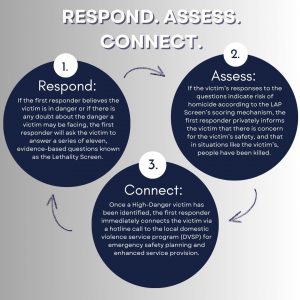Lethality Assessment Protocol (LAP)
Intimate partner violence is all too common in North Carolina. The North Carolina Department of Justice (NCDOJ) is committed to partnering with local communities by sharing the Lethality Assessment Protocol (LAP), an evidence-base protocol that both identifies the most dangerous emergency calls and then connects these victims with critical safety tools.
What is the Lethality Assessment Protocol (LAP)?
The LAP, created by Maryland Network Against Domestic Violence in 2005, is an innovative program designed to prevent intimate partner homicides and serious abuse. As a part of the LAP, officers use an eleven question instrument called the Lethality Screen to assess a victim’s risk of being killed by an intimate partner. When a victim is identified as “High-Danger” according to their answers on the Screen or the circumstances of the call for service, the officer calls the DVSP hotline immediately and offers the victim the chance to speak with an advocate about their safety and DVSP services. The LAP 2.0 enables first responders and advocates to work as equal partners in a more coordinated, communicative, and collaborative way to engage victims who otherwise may not access the life-saving services of the DVSP.
The LAP is one of the models of evidence-based intimate partner homicide prevention to be honored as a “promising practice” by the U.S. Department of Justice. It has also been validated as a “supported intervention” according to the Centers for Disease Control’s Continuum of Evidence Effectiveness.

Why LAP?
- Nearly half of abusers who kill their partners were arrested the year before and almost a third of victims had contacted the police.[1]
- LAP takes advantage of this contact to identify victims and connect them to resources that will provide more safety. Data shows that LAP can identify 92 percent of women facing near-fatal violence.[2]
- Victims who benefit from a LAP response are more likely to take action to protect themselves and prevent future violence.[3]
- A study of female homicide victimization by males in Maryland found a 35-45% reduction following successful implementation of the LAP.[4]
How to Bring LAP to My Community?
As the North Carolina LAP coordinator, NCDOJ will work with communities to assess readiness and then facilitate an on-site LAP training for communities who have successfully completed the application process and committed to program requirements.
Several North Carolina jurisdictions are putting LAP to work, including agencies in Alamance, Buncombe, Franklin, Henderson, Mecklenburg, Pitt, and Wake counties.
The NCDOJ wants to work with local agencies interested in building their capacity to bring the LAP model to NC communities. If you would like to learn more about LAP, please contact Kathleen Lockwood, Victim Servies Manager at klockwood@ncdoj.gov.
LAP Resource Hub for NC Coordinators
[1] Sharps, P. W., Koziol-McLain, J., Campbell, J. C., McFarlane, J., Sachs, C., & Xu, X. (2001). Health care providers missed opportunities for preventing femicide. Preventive Medicine 33, 373-80.
[2] Messing, J. T., Campbell, J. C., Wilson, J. S., Brown, S., Patchell, B., & Shall, C. (2014). Police departments’ use of the Lethality Assessment Program: A quasi-experimental evaluation. U.S. Department of Justice, Award No. 2008-WG-BX-0002
[3] Messing, J. T., Campbell, J. C., Wilson, J. S., Brown, S., Patchell, B., & Shall, C. (2014). Police departments’ use of the Lethality Assessment Program: A quasi-experimental evaluation. U.S. Department of Justice, Award No. 2008-WG-BX-0002
[4] Koppa, Vijetha. (2017). Can information Save Lives? Effect of a victim-focused police intervention in preventing domestic violence deaths. SSRN Electronic Journal. 10.2139/ssrn.2982227
